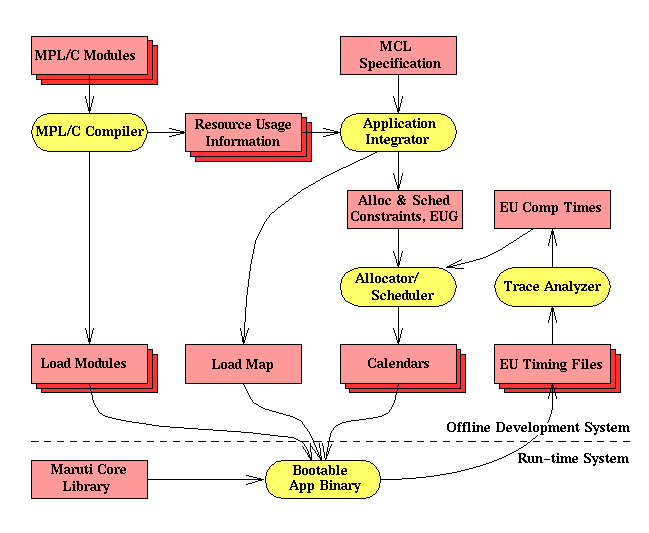


Department of Computer Science
University of Maryland
College Park, Maryland 20742
U.S.A.

The Maruti project started in 1988. The first version of the system was designed as an object-oriented system with suitable extensions for objects to support real-time operation. The proof-of-concept version of this design was implemented to run on top of the Unix operating system and supported hard and non-real-time applications running in a distributed, heterogeneous environment. The feasibility of the fault-tolerant concepts incorporated in the design of Maruti system were also demonstrated. No changes to the Unix kernel were made in that implementation, which was operational in 1990. We realized that Unix is not a very hospitable host for real-time applications, as very little control over the use of resources can be exercised in that system without extensive modifications to the kernel. Therefore, based on the lessons learned from the first design, we proceeded with the design of the current version of Maruti and changed the implementation base to CMU Mach which permitted more direct control of resources.
Most recently, we have implemented Maruti directly on 486 PC hardware, providing Maruti applications total control over resources. The initial version of the distributed Maruti has also been implemented, allowing Maruti applications to run across a network in a synchronized, hard real-time manner.
Design Goals
The design of a real-time system must take into consideration the primary
characteristics of the applications which are to be supported. The design
of Maruti has been guided by the following application characteristics
and requirements:
The most important requirement for real-time systems is the capability to support the timely execution of applications. In contrast with many existing systems, next-generation systems will require support for hard, soft, and non-real-time applications on the same platform.
Many of the mission-critical systems are safety-critical, and therefore have fault tolerance requirements. In this context, fault tolerance is the ability of a system to support continuous operation in the presence of faults.
Although a number of techniques for supporting fault-tolerant systems have been suggested in the literature, they rarely consider the real-time requirements of the system. A real-time operating system must provide support for fault tolerance and exception handling capabilities for increased reliability while continuing to satisfy the timing requirements.
The inherent characteristics of many systems require that multiple autonomous computers, connected through a local area network, cooperate in a distributed manner. The computers and other resources in the system may be homogeneous or heterogeneous. Due to the autonomous operation of the components which cooperate, system control and coordination becomes a much more difficult task than if the system were implemented in a centralized manner. The techniques learned in the design and implementation of centralized systems do not always extend to distributed systems in a straightforward manner.
Many real-time applications undergo different modes of operation during their life cycle. A scenario defines the set of jobs executing in the system at any given time. A hard real-time system must be capable of switching from one scenario to another, maintaining the system in a safe and stable state at all times, without violating the timing constraints.
The major challenge in building operating systems for mission-critical computing is the integration of multiple requirements. Because of the conflicting nature of some of the requirements and the solutions developed to date, integration of all the requirements in a single system is a formidable task. For example, the real-time requirements preclude the use of many of the fault handling techniques used in other fault-tolerant systems.
Hard real-time applications in Maruti have advance resource reservation resulting in a priori guarantees about the timely execution of hard real-time jobs. This is achieved through a calendar data structure which keeps track of all resource reservations and the assigned time intervals. The resource requirements are specified as early as possible in the development stage of an application and are manipulated, analyzed, and refined through all phases of application development.
Hard real-time jobs are scheduled using a time-driven scheduling paradigm in which the resource contention between jobs is eliminated through scheduling. This results in reduced run time overheads and leads to a high degree of predictability. However, not all jobs can be pre-scheduled. Since resources may be shared between jobs in the calendar and other jobs in the system, such as non-real-time activities, there may be resource contention leading to lack of predictability. This is countered by eliminating as much of resource contention as possible and reducing it whenever it is not possible to eliminate it entirely. The lack of predictability is compensated by allowing enough slack in the schedule.
Fault tolerance objectives are achieved by integrating the support for fault tolerance at all levels in the system design. Fault tolerance is supported by early fault detection and handling, resilient application structures through redundancy, and the capability to switch modes of operation. Fault detection capabilities are integrated with the application during its development, permitting the use of application-specific fault detection and fault handling. As fault handling may result in violation of temporal constraints, replication is used to make the application resilient. Failure of a replica may not affect the timely execution of other replicas and thereby the operation of the system it may be controlling. Under anticipated load and failure conditions, it may become necessary for the system to revoke the guarantees given to the hard real-time applications and change its mode of operation dynamically so that an acceptable degraded mode of operation may continue.
In the design of Maruti, an emphasis has been placed on separating mechanism from policy. Thus, for instance, the system provides basic dispatching mechanisms for a time-driven system, keeping the design of specific scheduling policies separate. The same approach is followed in other aspects of the system. By separating the mechanism from the policy, the system can be tailored and optimized to different environments.
Unlike many other real-time systems, the aim of the Maruti project has been to develop a system which can be tailored to use in a wide variety of situations-from small embedded systems to complex mission critical systems. With the rapid change in hardware technology, it is imperative that the design be such that it is portable to different platforms and makes minimal assumptions about the underlying hardware platform. Portability and extensibility is also enhanced by using modular design with well defined interfaces. This allows for integration of new techniques into the design with relative ease.
Many critical systems consist of applications with a mix of hard, soft, and non-real-time requirements. Since they may be sharing data and resources, they must execute within the same environment. The approach taken in Maruti is to support the integrated execution of applications with multiple requirements by reducing and bounding the unpredictable interaction between them.
Many embedded systems need several processors to carry out their computations. When multiple processors function autonomously, their use in hard real-time applications requires operating system support for coordinated resource management. Maruti provides coordinated, time-based resource management of all resources in a distributed environment including the processors and the communication channels.
Maruti provides support for multiple execution environments to facilitate program development as well as execution. Real-time applications may execute in the Maruti/Mach or Maruti/Standalone environments and maintain a high degree of temporal determinacy. The Maruti/Standalone environment is best suited for the embedded applications while Maruti/Mach permits the concurrent execution of hard real-time and non-real-time Unix applications. In addition, the Maruti/Virtual environment has been designed to aid the development of real-time applications. In this environment the same code which runs in the other two environments can execute while access to all Unix debugging tools is available. In this environment temporal accuracy is maintained with respect to a virtual real-time.
When an application executes in the Maruti/Virtual environment its interactions are carried out with respect to virtual real-time which is under the control of the user. The user may speed it up with respect to actual time or slow it down. The virtual time may be paused at any instant and the debugging tools used to examine the state of the execution. In this way we may debug an application while maintaining all temporal relationships, a process we call temporal debugging.
Dr. Ashok Agrawala
agrawala@cs.umd.edu
+1 (301) 405-2525Department of Computer Science
University of Maryland
College Park, MD 20742
U.S.A.Fax: +1 (301) 405-6707